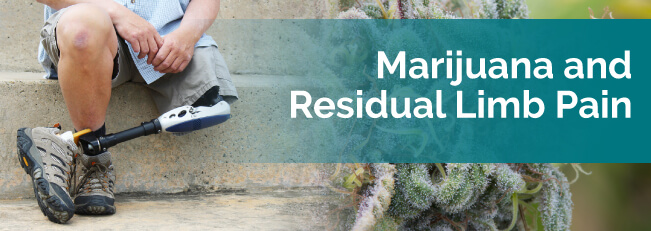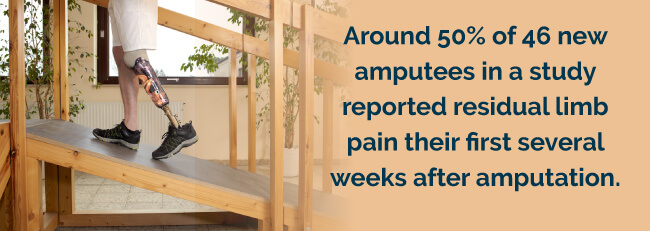
Many people end up having pain after they undergo surgery. It’s part of the natural healing process. But once your tissues begin repairing themselves, this pain typically subsides. When it comes to recovering and healing after an amputation though, it’s not that simple.
With an amputation, after the initial pain following your surgery subsides, you can start to experience other types of sensations, which can be unpleasant and painful. Some can be disconcerting and strange.
When you experience isolated pain in the area of your amputation, it is known as residual limb pain, or RLP. As you’ll see, studies show that medical cannabis for residual limb pain can be very effective for reducing this pain and even helping to address other underlying causes of pain.
As mentioned, residual limb pain is the pain you feel at the remaining part of your limb. Some surgery-related conditions or pre-existing conditions you’ve already had before your amputation can cause this pain.
You’ll want to work closely with your doctor to carefully identify the cause and origin of your pain so you can receive the right treatment for it. Potential causes of RLP include:
At some point following an amputation, some people experience phantom pain. You’re more at risk of phantom pain if you had severe pain that lasted a while before your amputation. In most cases, phantom pain is worse early after your amputation but decreases over time.
RLP is most often associated with an amputation of an arm or leg, but it can also occur after a traumatic or surgical amputation of any body part, including the tongue or breast.
Until recently, the main reason for phantom limb pain was believed to be irritation in the severed nerve endings (neuromas). With an amputated limb, many of the severed nerve endings are cut off at the residual limb. When these nerve endings become inflamed, they send abnormal brain signals. The hypothesis was that the brain interpreted these signals as pain, since they were functionally nonsense.
Most of the treatments based on this hypothesis were typically failures. Surgeons, in extreme cases, would shorten the stump with a second amputation hoping to remove the inflamed nerve endings and relieve the phantom pain. However, patients experienced a worsening in their phantom pain and many ended up with not only the sensation of a new phantom stump with new pain, but the original phantom limb pain as well.
By the late 1980s, pain researcher Ronald Melzack had recognized that this hypothesis of irritated nerve endings wasn’t correct. He felt that a whole network of interconnecting neural structures was responsible. In 1991, National Institutes of Health’s Tim Pons and his team discovered that the central somatosensory cortex found in monkeys is subject to significant reorganization following sensory input loss.
After hearing about these results, neuroscientist Vilayanur S. Ramachandran hypothesized that humans experienced the phantom limb sensations due to somatosensory cortex reorganization found in the postcentral gyrus and which takes in input from the body and limbs. Ramachandran and his team proved this hypothesis by showing that stroking various facial parts led a person to perceive being touched on various areas of the missing limb.
Residual limb pain can be mild for some individuals and agonizing for others. For some people, it can even be disabling. It also can lead you to deal with chronic pain for a lifetime. If you have RLP, you might feel a pain that is stabbing, burning, sharp or dull. Additionally, you might experience these other sensations:
Some individuals may feel as though the missing limb is swaying or moving. You might also experience “stump pain” at the amputation site. You may even feel a sensation in the part of the phantom limb that you may have experienced before the limb was removed.
Chronic pain is widespread among individuals who have lost a limb, regardless of when their limb was amputated. According to a National Center for Biotechnology Information (NCBI) study involving 914 peoplewith limb loss:

When you have a lower limb amputation, it’s not uncommon to develop a loss in bone density or osteoporosis due to decreased weight load, altered gait pattern, lack of muscular action and disuse atrophy.
After surgical trauma, you may have poor tissue coverage that the bone at the end of your limb causes due to not being trimmed properly during your surgery. This may also cause pain while wearing your prosthesis. When padding or other techniques aren’t a success, you may require surgery to amend your residual limb to help alleviate your pain and enable you to wear your prosthesis.
You may also develop a neuroma, which is a bundle or collection of nerve endings that forms under your residual limb’s skin. You can equate this to a tangle of hair. It may get sensitive, particularly if this tangle is pressing on your prosthesis.
Because of intense residual limb pain, you might develop depression.
Residual limb pain is fairly common in earlier post stages of amputation. RLP statistics reveal that:

Successful treatment for pain after an amputation depends on how intense your pain is and the number of mechanisms that play a role in causing the pain. In addition to physical therapy and cognitive behavior therapy, some recommended treatments used to treat RLP are:
This is a type of physical therapy designed for patients experiencing post-amputation pain. It can be very effective. During this treatment, patients watch in a mirror while they receive physical therapy to help them re-map their brain’s neural pathways to recognize that the limb no longer exists.
There are reported side effects of mirror box therapy. One study published in the American Journal of Physical Medicine & Rehabilitation showed limited reports of any side effects, but included:
A possible reason for these reported side effects could be because this type of therapy was paralleled by a standard approach to rehabilitation that targeted prosthesis use.
During this treatment, your doctor injects the amputation site with a local pain-blocking agent. This calms the painful signals the brain receives from the nerve endings. Stellate ganglion blocks are used for upper extremities while lumbar sympathetic blocks are used for lower extremities.
Possible side effects of local injection therapy may include:
These are prescription pain relievers that limit or slow how your brain receives the signals of sensitive nerves. Some common side effects of non-opiate analgesics may include:
During this method, a surgeon will place small electrodes directly on your brain’s surface to send electrical impulses that help attenuate pain. Common side effects of deep brain stimulation may include:
The nerve cuff stimulation method involves your doctor placing a stimulator on your nerves that travels to your amputated limb. This stimulator looks like a wrapper on a straw but is only about a centimeter long. There’s a tiny electrode inside of it and it covers the nerve. It sends your nerve a pleasant signal instead of blocking the nerve signals.
The doctor activates the cuff located at the nerve ending with a small wireless remote control. Once you begin feeling pain, the physician simply presses a button that delivers an imperceptible electrical stimulation that replaces the sensation of pain as it travels to your brain.
Most individuals seem to tolerate this method fairly well.
Patients who suffer from residual limb pain have come to discover the pain-relieving properties of marijuana as an alternative medicine. This alternative remedy treats a wide variety of painful symptoms associated with residual limb pain. Because marijuana treats pain under such diverse circumstances, this miracle plant appears to be a promising source of analgesic medications to relieve residual limb pain.

Each component of marijuana can provide an exceptional form of relief for one of the many symptoms associated with this chronic or debilitating condition. If you feel that you would benefit from marijuana as an alternative medicine, please contact our service.
Common mild side effects of medical weed for residual limb pain include:
Rarer side effects could include:
There may be other side effects of marijuana for residual limb pain that you’ll want to discuss with your doctor before starting this form of treatment.
Cannabis is an effective treatment to treat residual limb pain while your doctor works on finding the source of the pain. Pot is a viable alternative for people who don’t want to take narcotic or synthetic pain medications. Medical marijuana may be effective in treating a broad range of physical suffering directly related to residual pain.

The analgesic properties of marijuana have been scientifically proven to effectively lessen your pain in several various circumstances which make weed a promising treatment for residual limb pain.
Not only does cannabis help provide relief from pain that’s directly associated with RLP, but its natural function also creates a more relaxed mental and physical state. This state of being serves to lessen stress and anxiety that often exacerbates pain.
Your medical marijuana doctor may recommend balms and topical ointments since you can place them directly on your residual limb. Topicals don’t give you those psychoactive effects — however, they’re still therapeutic.
Also, since medical marijuana is becoming legal in more and more states, there’s greater access to medical weed. This means that if you’re suffering from RLP, you may be able to use cannabis for residual limb pain instead of harmful and addictive narcotics.
Marijuana can be an excellent choice to treat your RLP symptoms. Certain cannabinoids are effective at reducing inflammation and may be helpful in individuals with an excess buildup of scar tissue. The THC in medical marijuana can also help hinder bone breakdown and stimulates new bone formation.
Weed can treat a wide range of painful symptoms associated with RLP, such as:
Since cannabis can be used to relieve pain under diversified situations, it also appears as a promising analgesic medication treatment to relieve RLP.
Your RLP may become severe when you don’t have the proper analgesic to ease the pain. Your discomfort can get more unbearable and intense. But using pot provides you with an organic choice that can be highly effective at combating your pain.
There are three main categories of medical marijuana strains:
Some cannabis strains that can help with RLP include:
There are other strains of cannabis that can help you manage residual limb pain. It’s best to work with your medical marijuana doctor and budtender to find the best strain or combination of strains that works for you.
To obtain relief from your RLP symptoms, search for a medical dispensary or cannabis doctor today. You don’t have to live with the intense pain that comes with residual limb pain.
Find A Doctor Find A Dispensary